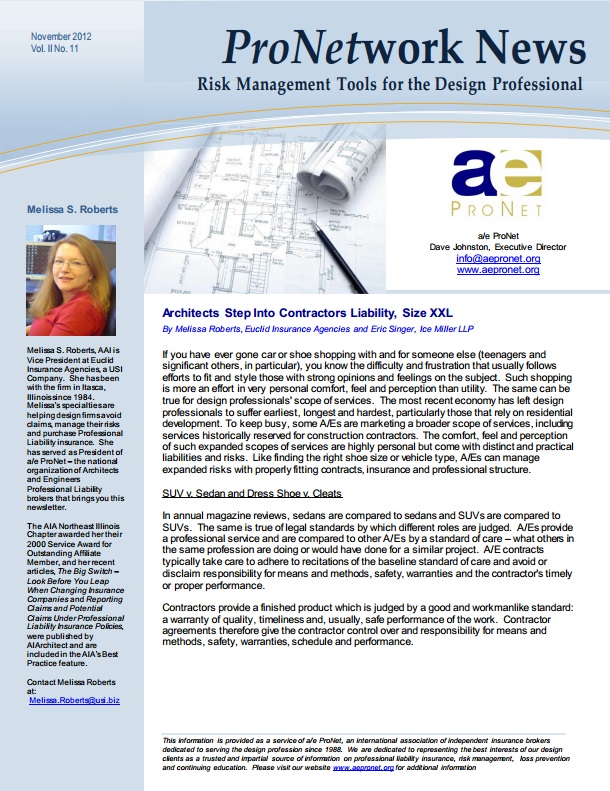 If you have ever gone car or shoe shopping with and for someone else (teenagers and significant others, in particular), you know the difficulty and frustration that usually follows efforts to fit and style those with strong opinions and feelings on the subject. Such shopping is more an effort in very personal comfort, feel and perception than utility. The same can be true for design professionals’ scope of services. The most recent economy has left design professionals to suffer earliest, longest and hardest, particularly those that rely on residential development. To keep busy, some A/Es are marketing a broader scope of services, including services historically reserved for construction contractors. The comfort, feel and perception of such expanded scopes of services are highly personal but come with distinct and practical liabilities and risks. Like finding the right shoe size or vehicle type, A/Es can manage expanded risks with properly fitting contracts, insurance and professional structure.
If you have ever gone car or shoe shopping with and for someone else (teenagers and significant others, in particular), you know the difficulty and frustration that usually follows efforts to fit and style those with strong opinions and feelings on the subject. Such shopping is more an effort in very personal comfort, feel and perception than utility. The same can be true for design professionals’ scope of services. The most recent economy has left design professionals to suffer earliest, longest and hardest, particularly those that rely on residential development. To keep busy, some A/Es are marketing a broader scope of services, including services historically reserved for construction contractors. The comfort, feel and perception of such expanded scopes of services are highly personal but come with distinct and practical liabilities and risks. Like finding the right shoe size or vehicle type, A/Es can manage expanded risks with properly fitting contracts, insurance and professional structure.
SUV v. Sedan and Dress Shoe v. Cleats
In annual magazine reviews, sedans are compared to sedans and SUVs are compared to SUVs. The same is true of legal standards by which different roles are judged. A/Es provide a professional service and are compared to other A/Es by a standard of care – what others in the same profession are doing or would have done for a similar project. A/E contracts typically take care to adhere to recitations of the baseline standard of care and avoid or disclaim responsibility for means and methods, safety, warranties and the contractor’s timely or proper performance.
Contractors provide a finished product which is judged by a good and workmanlike standard: a warranty of quality, timeliness and, usually, safe performance of the work. Contractor agreements therefore give the contractor control over and responsibility for means and methods, safety, warranties, schedule and performance.
Crossovers and Hybrids
There is a line between trucks and cars, but there are luxury SUVs and crossovers to blur the line and offer compromises of varying degree. The line between A/E services and contractor services has become equally fuzzy. Try to explain in words the difference between the scope of services of a Construction Manager/Advisor, a Program Manager and an Owner’s Representative. For example: The label is less important than the intended division of responsibility, control and money, and how that is expressed in a contract. Continue reading “Architects Step Into Contractors Liability, Size XXL”
 Using a real-life claims scenario from “a structural engineer and senior partner in a small A/E firm that specialized in multi-family and commercial condominium projects”, William F. Dexter offers his view on the Top 3 Liabilities Facing Design Professionals in today’s increasingly litigious marketplace:
Using a real-life claims scenario from “a structural engineer and senior partner in a small A/E firm that specialized in multi-family and commercial condominium projects”, William F. Dexter offers his view on the Top 3 Liabilities Facing Design Professionals in today’s increasingly litigious marketplace:
